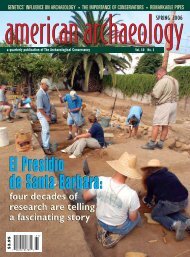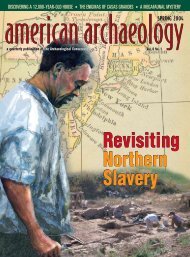Clovis Comet Debate - The Archaeological Conservancy
Clovis Comet Debate - The Archaeological Conservancy
Clovis Comet Debate - The Archaeological Conservancy
You also want an ePaper? Increase the reach of your titles
YUMPU automatically turns print PDFs into web optimized ePapers that Google loves.
george nicHolaS<br />
Values and Scientific Practice, called “one of the first salvos<br />
from American Indian groups for control of their own<br />
history and their cultural artifacts.” Two years later, Native<br />
Americans disrupted excavations in Welch, Minnesota, and<br />
another group occupied the Southwest Museum in Los<br />
Angeles to protest the display of sacred artifacts.<br />
<strong>The</strong>se and other conflicts over the control of artifacts<br />
continued in subsequent decades. Among the most contentious<br />
was the fight over a 9,400-year-old skeleton that<br />
washed out of an eroded riverbank along the Columbia<br />
River in 1996. <strong>The</strong> Army Corps of Engineers assumed control<br />
of the skeleton, named Kennewick Man, and announced its<br />
intention to repatriate the bones to five local tribes. Eight<br />
non-native scientists filed a lawsuit to stop this, marking the<br />
first in a series of suits, findings, and plans for the disposition<br />
of the site and the remains.<br />
<strong>The</strong> divide between native and non-native claims over<br />
artifacts has long deterred many young Native Americans<br />
from entering the field of archaeology. But that began to<br />
change in the 1980s and 1990s—more indigenous students<br />
entered the field, in part to become gatekeepers to their own<br />
heritage. For 16 years, George Nicholas directed an archaeological<br />
program on a small satellite campus that Simon<br />
Fraser University opened on the Kamloops reserve in British<br />
Columbia. “What I saw emerge beginning in the 1990s was<br />
that more First Nations or Native Americans were seeking the<br />
tools by which they could start to do archaeology,” Nicholas<br />
said. “My philosophy was: here are the tools of archaeology,<br />
but it’s not my expectation that you use these tools in the<br />
same way I use them.”<br />
Watkins defines indigenous archaeology as “archaeology<br />
that takes into account indigenous perspectives on the past<br />
and discussing the relationships between the past and contemporary<br />
society.” He doesn’t believe that traditional and<br />
indigenous archaeology need be mutually exclusive. “I think<br />
they can be bridged as long as neither one presumes the<br />
other to be wrong,” he said. ”I think a problem arises when<br />
we dismiss traditional knowledge out of hand at the beginning<br />
rather than wondering if there’s some way the two of<br />
them can work together.”<br />
What indigenous archaeology is not may be easier to<br />
grasp than what it is. Nicholas’ encyclopedia entry defining<br />
indigenous archaeology now runs more than 5,000 words.<br />
“Indigenous archaeology is an expression of archaeological<br />
theory and practice,” the entry begins, “in which the<br />
discipline intersects with indigenous values, knowledge,<br />
practices, ethics, and sensibilities, and through collaborative<br />
and community-originated or -directed projects, and related<br />
critical perspectives.”<br />
“It’s a really slippery thing,” Nicholas admitted. ”But you<br />
know it when you see it.”<br />
rob e rt mcghe e, t h e f o r m e r cu r at o r o f<br />
Arctic Archaeology at the Museum of Civilization in Ottawa,<br />
Field school students at Simon Fraser University’s Kamloops Indigenous Archaeology Program review the day’s excavation results.<br />
american archaeology 39




